To verify the energy gains of PERC bifacial modules in different environments, LONGi cooperated with the top third-party organizations to build many pilot projects in 2018. Among them, pilot project of TÜV SÜD in Hainan focused on the energy gain of bifacial modules under different surface reflection conditions and verify the effects of the modules with the installing heights of 1.0 m and 1.5 m. The power station has accumulated more than 8 months of data since September 2018. The article will show the power generation of the LONGi bifacial modules based on the data.
Project information
Located in Ding’an County, Hainan, the specific information of pilot project is shown in the following table:

The module array diagram is shown as below. R5~R7 reduces the array spacing due to the lower installation height. In addition, in the south of the array and in other module arrays, all the pilot modules have similar shading conditions:
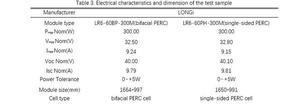

There are two types of modules for this test. The specific parameters are shown in the following table.

The field installation of different surface is as shown in Figure 2. To test the accuracy of the irradiance, an irradiator is installed on the steel of the front module to record the irradiance of oblique incidence, and two irradiators are installed at the top and bottom of the rear module to record the irradiance reflected from the rear side respectively. Thermocouples are also installed at the middle and edge of the rear module of each array to test the actual operating temperature.
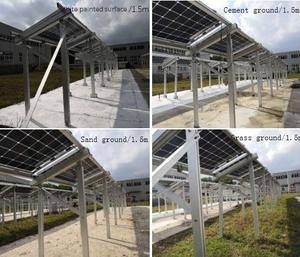
Influence of surface reflectance and module height on energy gain of the bifacial modules
The average daily energy gain per module from September 2018 to April 2019 is shown in Figures 3 and 4. The data shows that compared with the single-sided PERC modules, the energy gains of bifacial PERC modules under the installation height of 1.5 meters are respectively 10.10%, 15.82%, 14.50% and 20.59% in the grass ground, sand ground, cement ground and white painted environments, which is in line with the trend that the higher the surface reflectance, the higher the energy gain. The energy gain is as high as 20.59% on the white painted surface with a reflectivity of 67.21%, and 10.10% on the grassland, which is higher than expected value.

Figure 4 shows that when the installation height is increased from 1 m to 1.5 m, the energy gain of the bifacial modules gets significantly increased, the energy gains on the grass ground and sand ground increases by 2.23% (absolute value) and 3.40%, respectively, which meets the expectation: the higher the surface reflectance, the better the energy gain.
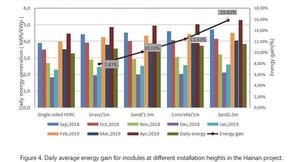
Monthly energy gain difference
According to experience, the energy gain of the bifacial modules presents such a trend that it is a slightly higher in summer than in winter, because of the periodic variation of the solar elevation angle and the long duration in the summer morning and evening (Scattered light ratio is relatively high) are longer. Figure 5 shows the energy gain of the monthly bifacial modules and the same trend exists on grass ground and cement ground at low latitude such as Hainan though not obviously as in relatively high latitudes, the energy gain in January and February of 2019 is over 5% lower than that in other months, which mainly caused by the change of the solar elevation angle: the lower solar elevation in the winter causes the large self-shadow of the array, so the high reflectance of white paints is less prominent in summer.
The current data are collected from September 2018 to April 2019, the annual energy gain will be higher than the average gain of previous eight months in consideration of the seasonal factors of energy gain.
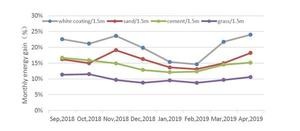
Module operating temperature difference
With two temperature sensors on the rear side of the modules, the operating temperature difference between bifacial modules and single-sided modules can be studied. Theoretically, on the one hand, the light received on the rear side for the bifacial modules will increase the operating current of the component to increase the module operating temperature. On the other hand, the transmittance of the bifacial PERC cell to the infrared radiation is higher than that of the single-sided cell, and the lowed thermal effect produced by the infrared radiation reduces the module operating temperature. From Figure 6, the operating temperature of all the bifacial modules on different surfaces (in the edge and middle of the modules) is lower than that of the single-sided modules. The average operating temperature of the bifacial modules on grass ground concrete ground and sand ground is 1.5C lower than that of the single-sided modules. The operating temperature of the bifacial modules on a white painted surface is 0.91C lower than that of single-sided modules. In addition to the infrared transmittance factor, it should be related to the 2mm + 2mm glass adopted by the LONGi bifacial modules, whose heat dissipation speed is significantly better than that of the 3.2mm glass + backsheet module.
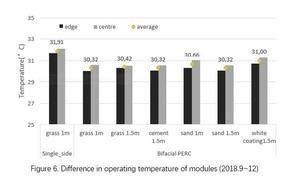
Estimating energy gain with rear side irradiation values
The project collects real-time rear side irradiation values of the bifacial modules (the average value in the middle and bottom is taken), so it is possible to estimate the energy gain of bifacial modules by multiplying the ratio of the rear side and front side radiation by the bifaciality. The theoretical energy gain in Figure 7 is the estimated value. The visible estimated value is perfectly matched with the measured gain in the trend, while it is slightly higher than the measured value due to the uneven rear side irradiation of the array.

Correlation between the energy gain and scattered light ratio
Next, take the sand land as an example to show the correlation between scattered light ratio and the energy gain. Since the scattered light can be directly received by the rear side of the modules, and the direct light is weakened by the surface reflection, the high scattered light ratio will increase the energy gain of the bifacial modules, and the lower the surface reflectance, the more obvious the effect. Figure 8 shows the energy gain and scattered light ratio from October 2 to November 30, 2018,which demonstrates that there is a significant correlation between the scattered light ratio and the energy gain. The date with high scattered light ratio tends to be more energy gain that the neighboring days.

System efficiency
Figure 9 summarizes the system efficiency (PR value) for each array of pilot projects. After using bifacial modules, the system efficiency is generally over 90%, and the system efficiency of the bifacial module array on the white painted surface reaches nearly 100%.
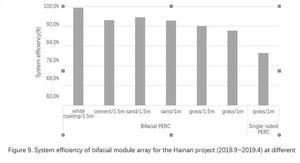
In summary, the TÜV SÜD Hainan pilot project fully verified the excellent power generation performance of the LONGi Hi-MO PERC bifacial modules, and specifically verified the effects of reflectance, installation height, and scattered light ratio on the bifacial energy gain. The data from the pilot project shows that the bifacial PERC module can generate considerable bifacial energy gain under various reflection conditions, which can significantly improve the efficiency of the power station system and significantly reduce the PV power generation LCOE, the company claims. (HCN)







